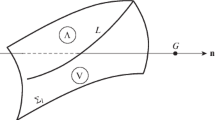Abstract
The transient stress and the transient average orientation generated by the breakup process of a long Newtonian filament imbedded in a quiescent Newtonian viscous liquid have been calculated. Rayleigh disturbances were used to describe the relaxation of the filament and the variation of interfacial area in the absence of flow during the course of disintegration process. The effect of viscosity ratio and initial radius of the filament were discussed. It was demonstrated that the predictions of the model in terms of the time-evolution of interfacial area can be used to select the best conditions for carrying out the breaking thread experiments. The predictions of the proposed model were compared to some experimental data on polyamide/polyethylene system.










Similar content being viewed by others
References
Batchelor GK (1970) The stress system in a suspension of force-free particles. J Fluid Mech 41:545–570
Bousmina M (1999) Linear and non linear rheology of polymer blends: drop deformation and fiber breakup processes. Keynote lecture at Polybelnd’s99, Boucherville, 12–15 October 1999
Bousmina M (2000) Plenary lecture. International Symposium on Rheology, dedicated to the 90th birthday of Prof. GV Vinogradov, Karacharovo, Russia, 22–27 May 2000
Chandrasekhar S (1964) Hydromagnetic problems in physics and astronomy. In: Brittin E (ed) Lectures in theoretical physics, vol 6. University of Colorado Press, Boulder, Colorado
Cristini V, Lawzdziewicz JB, Loewenberg M, Collins LR (2003a) Breakup in stochastic Stokes flows: sub-Kolmogorov drops in isotropic turbulence. J Fluid Mech 492:231–250
Cristini V, Guido S, Alfani A, Bawzdziewicz J, Loewenberg M (2003b) Drop breakup and fragment size distribution in shear flow. J Rheol 47:1283–1298
Doi M, Ohta T (1991) Dynamics and rheology of complex interfaces. J Chem Phys 95:1242–1248
Elemans PHM, Janssen JM, Meijer HEH (1990) The measurement of interfacial tension in polymer/polymer systems: the breaking thread method. J Rheol 34:1311–1325
Elmendorp JJ (1986) A study on polymer blending microrheology. Polym Sci Eng 26:418–426
Kaplan K (1973) Advanced calculus, 2nd edn. Addison-Wesley, Ontario, chap 5
Knops YMM, Slot JJM, Elemans PHM, Bulters JH (2001) Simultaneous breakup of multiple viscous threads surrounded by viscous liquid. AIChE J 47:1740
Kuhn W (1953) Spontane Aufteilung von Flussigkeitszlindern in kleine kugeln. Kolloïd Z 132:84–99
Onuki A (1987) Viscosity enhancement by domains in phase-separating fluids near the critical point: proposal of critical rheology. Phys Rev A 35:5149–5155
Plateau J (1849) Acad Sci Bruxelles Mém 23:5
Plateau M (1873) Statique expérimentale et théorique des liquides soumis aux seules forces moléculaires, vol II, p 231
Rayleigh L (1879) On capillary phenomena of jets. Proc R Soc London 29:71–97
Renardy Y, Cristini V, Li J (2002) Drop fragment distributions under shear with inertia. Int J Multiphase Flow 28:1125–1147
Rosenkilde CE (1967) Surface-energy tensor. J Math Phys 8:84–88
Tomotika S (1935) On the instability of a cylindrical thread of a viscous liquid surrounded by another viscous fluid. Proc R Soc London Ser A 150:322–337
Xing P, Bousmina M, Rodrigue D, Kamal MR (2000) Critical experimental comparison between five techniques for the determination of interfacial tension in polymer blends: model system of polystyrene/polyamide-6. Macromolecules 33:8020–8033
Acknowledgements
This work was financially supported by the NSERC (Natural Sciences and Engineering Research Council of Canada) and Canada Research Chair on Polymer Physics and Nanomaterials.
Author information
Authors and Affiliations
Corresponding author
Rights and permissions
About this article
Cite this article
Zkiek, A., Yu, W., Bousmina, M. et al. Transient stress and interfacial area generated during breakup of a Newtonian thread immersed in a Newtonian medium. Rheol Acta 43, 333–341 (2004). https://doi.org/10.1007/s00397-003-0346-3
Received:
Accepted:
Published:
Issue Date:
DOI: https://doi.org/10.1007/s00397-003-0346-3



